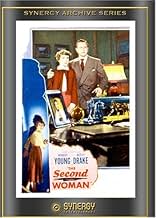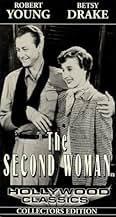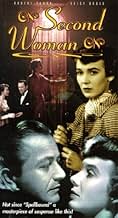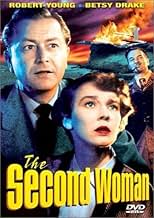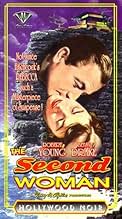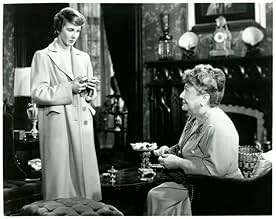IMDb RATING
6.3/10
1.5K
YOUR RATING
In flashback from a 'Rebecca'-style beginning: Ellen Foster, visiting her aunt on the California coast, meets neighbor Jeff Cohalan and his ultramodern clifftop house.In flashback from a 'Rebecca'-style beginning: Ellen Foster, visiting her aunt on the California coast, meets neighbor Jeff Cohalan and his ultramodern clifftop house.In flashback from a 'Rebecca'-style beginning: Ellen Foster, visiting her aunt on the California coast, meets neighbor Jeff Cohalan and his ultramodern clifftop house.
Jason Robards Sr.
- Stacy Rogers
- (as Jason Robards)
Jimmie Dodd
- Mr. Nelson
- (as Jimmy Dodd)
Smoki Whitfield
- Porter
- (scenes deleted)
Walter Bacon
- Country Club Guest
- (uncredited)
Vince Barnett
- Giovanni Strobini
- (uncredited)
Paul Bradley
- Country Club Guest
- (uncredited)
- Director
- Writers
- All cast & crew
- Production, box office & more at IMDbPro
Featured reviews
I really enjoyed this film. It has a fairly believable premise. I do have a little trouble with the self-sacrifice angle and the idea of taking things to the grave that could be dealt with, but it has lots of suspense and a cool ending. Robert Young is carrying around a secret. He is being daily harassed by someone. His dog is killed, his house is burned, his horse is harmed (to the point where it needs to be destroyed), and his livelihood (as an architect) is being compromised. He meets a young woman who makes him happy, but she can't convince him to come clean. There is a plot to portray him as psychotic (actually paranoid), He seems to have some handle on everything but won't say what it is. There is excellent cinematography. The pacing is quite good. I have to admit I never suspected what was going on. It's a captivating film. The acting is quite good. Oh, yes, as I see these films, I have seen the presence of Jimmy Dodd who was the head Mousketeer on the old Mickey Mouse Club show of the fifties. His acting portfolio is rather extensive though unimpressive.
Robert Young is one seemingly unlucky guy in "The Second Woman," a 1950 film also starring Betsy Drake, Morris Carnovsky, John Sutton, Florence Bates and Henry O'Neill. This was probably a 'B' noir; like "Shining Victory" and "The Uninvited," it is reminiscent of "Rebecca" - in fact, the beginning narration is basically a paraphrase of "Last night I dreamt I went to Manderlay." This film even goes so far as to have Florence Bates playing Drake's aunt; she was Mrs. DeWinter's employer in "Rebecca." Drake is Ellen Foster, a young woman en route by train to visit her aunt when she meets her aunt's attractive neighbor, Jeff Cohalon (Young). He's built a fantastic house that, her aunt informs Ellen, no one has ever been in. He built it for his bride-to-be, and she was killed in a car accident before the wedding. Since then, several people - his almost father-in-law, Ben (O'Neill), to whom Jeff is like a son, and a psychiatrist, Dr. Hartley (Carnovsky) have been concerned about Jeff. He seems absent-minded and moody. Then strange things begin to happen to Jeff - he has to shoot his horse when it breaks its leg apparently while in its stall; his dog dies; the color on a painting he owns suddenly fades; and roses he brings into the house die immediately. Ellen, who works with actuarial tables, is darn suspicious - there is too much bad luck, and either Jeff himself or someone who wants him destroyed is behind it.
"The Second Woman" is a decent film with good, if unexciting, acting. Robert Young made several noirs in the '40s, and he did them well - you really don't know here if he's sinister or if he's a victim. Drake is a bland costar. Carnovsky, O'Neill, Sutton and Bates give good support. Sutton strikes the right note as a man who hates Jeff.
Like dozens and dozens of post-World War II, there is an emphasis on psychology. Considering what our soldiers went through in World War II, it's not surprising that it was a hot topic. Here the big word is paranoia. But as anyone will tell you, just because you're paranoid doesn't mean someone's not out to get you.
"The Second Woman" is a decent film with good, if unexciting, acting. Robert Young made several noirs in the '40s, and he did them well - you really don't know here if he's sinister or if he's a victim. Drake is a bland costar. Carnovsky, O'Neill, Sutton and Bates give good support. Sutton strikes the right note as a man who hates Jeff.
Like dozens and dozens of post-World War II, there is an emphasis on psychology. Considering what our soldiers went through in World War II, it's not surprising that it was a hot topic. Here the big word is paranoia. But as anyone will tell you, just because you're paranoid doesn't mean someone's not out to get you.
It's opening speech tries far too hard to evoke associations with 'Rebecca' (it even features one of the original cast), and it also shoehorns in references to 'Suspicion' and 'Spellbound'. But it actually works perfectly own on it's own terms - with a bit of postwar psychology thrown in and Tchaikovsky on the soundtrack - and ironically harks forward towards later Hitchcocks (notably 'North by Northwest') with it's hero and heroine meeting cute on a train and the hilltop Frank Lloyd Wright-style house that serves as a backdrop to some of the drama.
A chicly attired Betsy Drake - ironically Mrs Cary Grant at the time - provides an attractive and robust female lead.
A chicly attired Betsy Drake - ironically Mrs Cary Grant at the time - provides an attractive and robust female lead.
What this b&w noir has going for it is the scenic grandeur of the central California coastline. The roiling sea and rocky outcrops, along with the ultra-modern (circa 1950) cliff house, provide an unusual backdrop to this psychological drama. Bad things keep happening to architect Jeff (Young) for no apparent reason, starting with the highway death of his wife. Enter Ellen (Drake) who seeks to uncover the mystery, though the finger of guilt begins to point at a grieving Jeff who may now be unhinged.
Both the script and the staging are excellent until the climax, which should have been reconsidered from both ends, especially the ludicrous gunshot that seemingly takes minutes to register. Drake's an appealing actress and projects intelligence in the part. At the same time, she's unusual for a decade that emphasized buxom sex-goddesses, which she definitely is not. She and Young do make a well-matched screen couple. However, Young's performance is rather strange. I don't know if he was reaching for a particular effect, but his low-key demeanor never changes despite the many provocations. Unfortunately, it borders on both the boring and the implausible.
Nonetheless, it's an intriguing mystery and a real treat for the eye thanks to cinematographer Hal Mohr. Also, I can't help noticing that Harry Popkin produced this film, along with the noir classic DOA (1950) and such imaginative B-movies as The Well (1951) and The Thief (1952). I expect it was he who insisted on the scenic locations for this film, proving that noir need not be confined to gritty urban settings. Anyway, I think it's fair to surmise that Popkin was a producer, unlike many, who understood the artistic side of movie-making. It shows here.
Both the script and the staging are excellent until the climax, which should have been reconsidered from both ends, especially the ludicrous gunshot that seemingly takes minutes to register. Drake's an appealing actress and projects intelligence in the part. At the same time, she's unusual for a decade that emphasized buxom sex-goddesses, which she definitely is not. She and Young do make a well-matched screen couple. However, Young's performance is rather strange. I don't know if he was reaching for a particular effect, but his low-key demeanor never changes despite the many provocations. Unfortunately, it borders on both the boring and the implausible.
Nonetheless, it's an intriguing mystery and a real treat for the eye thanks to cinematographer Hal Mohr. Also, I can't help noticing that Harry Popkin produced this film, along with the noir classic DOA (1950) and such imaginative B-movies as The Well (1951) and The Thief (1952). I expect it was he who insisted on the scenic locations for this film, proving that noir need not be confined to gritty urban settings. Anyway, I think it's fair to surmise that Popkin was a producer, unlike many, who understood the artistic side of movie-making. It shows here.
This fine "B" film project is basically a psychological film, in the category of the many 1940s and 50s films that were made to explore depth-of-character and motivation. The idea their producers had was to go beyond the inspector calling and assembling suspects in the drawing room to detail who'd done a murder; in the newer mysteries, emphasis was placed upon gradually discovering clues and lines of inquiry, upon revealing actions, pretenses, questionings and complex relationships. This "modern" peeling away of layers of truth relating to an old crime's influence often works brilliantly in my judgment, especially in this movie, Not the least of this unpretentious and beautifully- photographed work's accomplishments is its avoidance of Freudian and false notions that so often muddy attempts to understand individuals' characters in film; Freud applies only to totalitarian societies. Here the investigator is in fact a beautiful woman, very intelligently played as insurance expert and woman-in-love by Betsy Drake. The object of her interest is a man who may or may not be crazy, well-portrayed by Robert Young. He has been suffering a series of accidents or breakdowns that are ruining his life; he has begun to doubt his own sanity. But she insightfully feelss someone is trying to wreck his career and his hopes for happiness. Their search for the perpetrator of the acts being done against him help them to unravel the mystery of his late wife's death and the secrets of the usual nasty small United States town and its equally small-minded citizens (a favorite target of intellectuals in the period, genuinely or not). The director was James V. Kerns, the cinematographer Hal Mohr, whose work was outstanding also. The cast apart from the attractive and bright leads was comprised of Morris Carnovsky, Jean Rogers, Steven Geray, Shirley Ballard, John Sutton and Florence Bates, all well-cast and in top form.. This film was an attempt to do on a low-budget what "Spellbound" had been able to accomplish; the house architect Young designs is outstanding modern architecture; the music by Bernard Nussbaum and the Tschaikovsky excerpts used are I believe add to the atmosphere very nicely. And the relations between characters, acerbic or warm, are unusually well-realized in dialogs and blocking.. This is a true sleeper, with its roots in "The Fountainhead"; and one that deserves much more attention that it has ever received; many elements of an intriguing mystery-noir storyline are quite successfully filmed here indeed.
Did you know
- TriviaAt the beginning of the movie, Robert Young's character tries to commit suicide by running his car engine in an enclosed garage. Then in flashback, the doctor says that he's concerned about Young's character's recurring bouts of depression. In real life, Young suffered from depression for decades, and tried to commit suicide in Westlake Village, CA in January 1991 by running a hose from his exhaust pipe into the interior of his car. Young called a tow truck to try to start his car. The driver noticed the hose, and contacted the police.
- GoofsIn the opening scene, Robert Young's character is discovered suffocated by heavy carbon monoxide in a sealed garage, but nobody else coming in the garage is affected by the deadly gas. Additionally, unless a car is burning oil or running very rich, exhaust fumes are not visible as was shown here. This reveals some type of smoke or vapor was used, not an actual auto exhaust.
- Quotes
Jeff Cohalan: Let's see what the tea leaves say about you... there's a trick my grandmother taught me; she learned it from an old witch in Ireland.
Ellen Foster: And so you've been drinking coffee ever since.
- ConnectionsReferenced in This Movie Must Die!: The Second Woman (1950) (2021)
- How long is The Second Woman?Powered by Alexa
Details
- Release date
- Country of origin
- Official sites
- Languages
- Also known as
- The Second Woman
- Filming locations
- Production company
- See more company credits at IMDbPro
- Runtime1 hour 31 minutes
- Color
- Aspect ratio
- 1.33 : 1
Contribute to this page
Suggest an edit or add missing content

